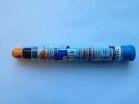(Press-News.org) A new study has examined how smoking-cessation aide varenicline may reduce drinking.
Results indicate that varenicline may reduce drinking by increasing alcohol's aversive effects.
Specifically, varenicline may increase blood pressure, heart rate, as well as ratings of dysphoria and nausea.
Varenicline is an effective smoking-cessation medication that may also reduce drinking. However, the means by which it might reduce drinking is unclear. A study of the effects of varenicline on subjective, physiological, and objective responses to low and moderate doses of alcohol among healthy social drinkers has found that varenicline may reduce drinking by increasing alcohol's aversive effects.
Results will be published in the May 2012 issue of Alcoholism: Clinical & Experimental Research and are currently available at Early View.
"Varenicline was first approved in the USA for treatment of nicotine dependence in 2006," said Emma Childs, research associate at the University of Chicago as well as corresponding author for the study. "Smokers who use varenicline are approximately two to three times more likely to remain abstinent six months or more after their quit date. After it was approved, several patients treated with varenicline also reported reductions in their drinking, so investigators began to assess if this was an actual effect and how it might be produced."
"Since there is a high comorbidity between nicotine and alcohol dependence, a single medication that could decrease the use of both substances would be ideal," added Hugh Myrick, associate professor of psychiatry as well as vice chair of the Psychiatry Practice Plan at the Medical University of South Carolina.
Childs and her colleagues assessed 15 healthy participants (8 males, 7 females) during six randomized sessions: three sessions each with 2 mg varenicline and placebo, followed three hours later by a beverage containing placebo, a low dose of alcohol (0.4g/kg), or a high dose of alcohol (0.8g/kg). Measures included subjective mood and drug effects such as stimulation and drug liking, physiological measures such as heart rate and blood pressure, and the results of eye-tracking tasks before and after drug and alcohol administration.
"We found that varenicline increased the unpleasant effects of alcohol and decreased drug liking," said Childs, "thus we think that varenicline may reduce drinking by altering the effects of alcohol."
"There are generally two ways that a medication may help reduce alcohol use," observed Myrick. "First, the rewarding aspects of alcohol could be reduced. An example of a medication that works by reducing reward is naltrexone, which blocks opiate receptors and therefore reduces the rewarding aspects of dopamine in the ventral striatum. Second, the aversive aspects of alcohol could be increased. In other words, the medication would cause symptoms leading to a decrease in alcohol use. Disulfiram, or Antabuse, is a medication that works by causing aversive effects if alcohol is consumed. Varenicline may work in a similar fashion."
"Our findings shed light on the mechanism underlying why people consume less alcohol when they have taken varenicline," said Childs. "The pleasurable effects of alcohol, for example feeling 'buzzed' and talkative, are associated with greater consumption and binge drinking. Some people lose control of their alcohol consumption during a drinking episode, for example they may aim to only have one or two drinks but end up drinking say four or five. If varenicline counteracts these positive effects by producing unpleasant effects, then as a result people may consume less alcohol during a drinking episode."
"Varenicline may find a nice niche in those individuals who are both nicotine and alcohol dependent," noted Myrick, "who we know represent a large portion of alcohol-dependent individuals."
###
Alcoholism: Clinical & Experimental Research (ACER) is the official journal of the Research Society on Alcoholism and the International Society for Biomedical Research on Alcoholism. Co-authors of the ACER paper, "Varenicline Potentiates Alcohol-Induced Negative Subjective Responses and Offsets Impaired Eye Movements," were: Daniel J.O. Roche and Andrea C. King of the Committee on Neurobiology at The University of Chicago; and Harriet de Wit of the Department of Psychiatry and Behavioral Neuroscience at The University of Chicago. The study was funded by the National Institute on Drug Abuse, and the National Institute on Alcohol Abuse and Alcoholism. This release is supported by the Addiction Technology Transfer Center Network at http://www.ATTCnetwork.org.
END
Alcohol abuse and dependence are common problems in the United States due to a number of factors, two of which may be social drinking by college students and young adults, and risk taking that may lead to heavier drinking later in life. A study of the neural underpinnings of risk-taking in young, non-dependent social drinkers has found that the caudate nucleus and frontal cortex regions of the brain show less activation in people who drink more heavily.
Results will be published in the May 2012 issue of Alcoholism: Clinical & Experimental Research and are currently ...
Frequent drinking can establish changes in the processing of alcohol cues that can, in turn, facilitate renewed drinking unless the resulting impulse to drink is inhibited.
A new study has looked at the interaction between automatically activated approach tendencies and adolescent ability and motivation to inhibit and reflect upon drinking behaviors.
Results show that stricter parental rules about drinking are highly protective, especially for males.
Frequent drinking can lead to changes in the processing of alcohol cues that can, in turn, facilitate renewed drinking ...
Intimate partner violence (IPV) has been linked to heavy drinking, and alcohol outlet density to violence.
A new study looks at links between alcohol outlet densities and IPV-related Emergency Department (ED) visits.
Findings showed that bars are positively related to IPV-related ED visits, while there is no relationship between restaurant density and IPV-related ED visits.
Intimate partner violence (IPV) has been linked to heavy drinking, substance use by one or both partners, and living in a neighborhood characterized by poverty and social disadvantage. Alcohol ...
Women with peripheral artery disease, or PAD, are two to three times more likely to have a stroke or heart attack than those without it ― yet it's often unrecognized and untreated, especially in women, according to a new American Heart Association scientific statement.
The statement is published in Circulation: Journal of the American Heart Association.
The American Heart Association, in collaboration with the Vascular Disease Foundation and its Peripheral Artery Disease Coalition, recommends healthcare providers proactively increase awareness of and test women ...
Hamilton, ON - For decades, the blood thinner heparin has been used to prevent and treat blood clots. Could it be just as effective in treating cancer?
In an editorial published today in the New England Journal of Medicine, researchers from McMaster University and the University at Buffalo suggest conclusive answers to key questions on the benefits of low molecular weight heparin (LMWH) for cancer patients remain elusive - despite promising results from large studies.
Co-authors of the editorial are Dr. Elie Akl, associate professor in the Department of Medicine in ...
According to the World Health Organization (WHO), one-third of the world's population is currently infected with tuberculosis bacteria. The bacteria is incredibly resistant to treatment, and despite its prevalence, very little is known about why it is so stress tolerant. But, researchers at the University of Pittsburgh have been developing a new way of culturing tuberculosis bacteria, which could lead to new insights and treatments.
"This is a significant step forward in TB research," said paper-author Dr. Anil Ojha, "because it shows in a very reproducible way how to ...
The Taurus Molecular Cloud, in the constellation of Taurus (The Bull), lies about 450 light-years from Earth. This image shows two parts of a long, filamentary structure in this cloud, which are known as Barnard 211 and Barnard 213. Their names come from Edward Emerson Barnard's photographic atlas of the "dark markings of the sky", compiled in the early 20th century. In visible light, these regions appear as dark lanes, lacking in stars. Barnard correctly argued that this appearance was due to "obscuring matter in space".
We know today that these dark markings are actually ...
UPTON, NY - Brain scans of two strains of mice imbibing significant quantities of alcohol reveal serious shrinkage in some brain regions - but only in mice lacking a particular type of receptor for dopamine, the brain's "reward" chemical. The study, conducted at the U.S. Department of Energy's Brookhaven National Laboratory and published in the May 2012 issue of Alcoholism: Clinical and Experimental Research, now online, provides new evidence that these dopamine receptors, known as DRD2, may play a protective role against alcohol-induced brain damage.
"This study clearly ...
Drug delivery into muscle using an autoinjector, akin to the EpiPen used to treat serious allergic reactions, is faster and may be a more effective way to stop status epilepticus, a prolonged seizure lasting longer than five minutes, according to a study sponsored by the National Institutes of Health. Status epilepticus is a potentially life-threatening emergency that causes 55,000 deaths each year. Anticonvulsant drugs are typically delivered intravenously (IV) as a first-line treatment.
Starting an IV in a patient experiencing seizures can pose a challenge for paramedics ...
Oral nutritional interventions help increase nutritional intake and improve some aspects of quality of life (QOL) in malnourished cancer patients or those who are at nutritional risk, but do not effect mortality, according to a study published February 15 in the Journal of the National Cancer Institute.
The American Cancer Society estimated 12 million new cancer diagnoses worldwide in 2007, expecting this to more than double in the next 50 years. While international guidelines have suggested a nutritional intervention with dietary advice and/or oral nutritional supplements ...

